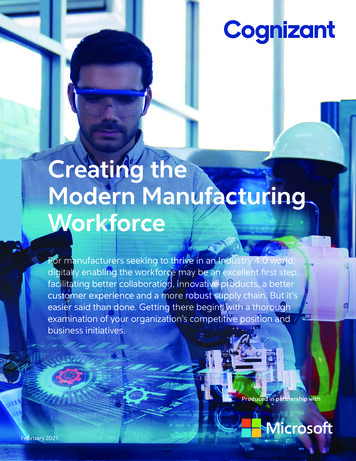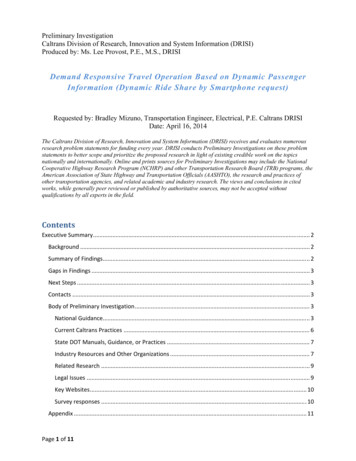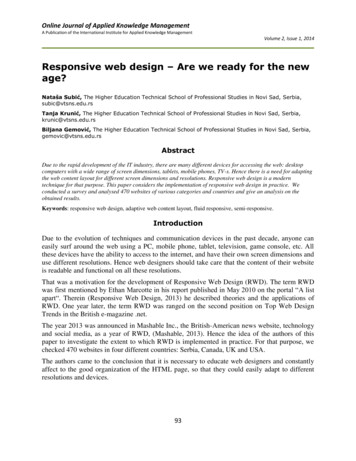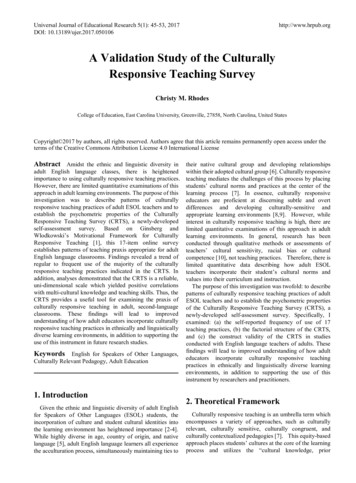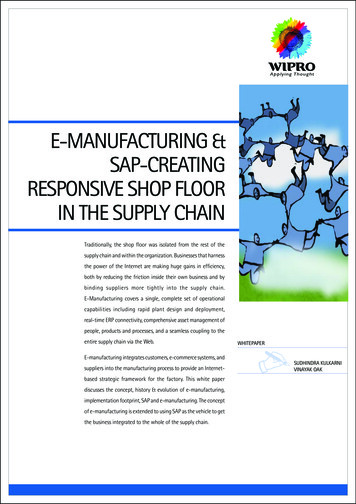
Transcription
E-MANUFACTURING &SAP-CREATINGRESPONSIVE SHOP FLOORIN THE SUPPLY CHAINTraditionally, the shop floor was isolated from the rest of thesupply chain and within the organization. Businesses that harnessthe power of the Internet are making huge gains in efficiency,both by reducing the friction inside their own business and bybinding suppliers more tightly into the supply chain.E-Manufacturing covers a single, complete set of operationalcapabilities including rapid plant design and deployment,real-time ERP connectivity, comprehensive asset management ofpeople, products and processes, and a seamless coupling to theentire supply chain via the Web.WHITEPAPERE-manufacturing integrates customers, e-commerce systems, andsuppliers into the manufacturing process to provide an Internetbased strategic framework for the factory. This white paperdiscusses the concept, history & evolution of e-manufacturing,implementation footprint, SAP and e-manufacturing. The conceptof e-manufacturing is extended to using SAP as the vehicle to getthe business integrated to the whole of the supply chain.SUDHINDRA KULKARNIVINAYAK OAK
E-manufacturing & SAP-Creating Responsive Shop Floor in the Supply ChainTable of ContentsINTRODUCTION . 3MANUFACTURING TRANSFORMATION . 4E-MANUFACTURING FOOTPRINT . 4REQUIREMENTS FOR E-MANUFACTURING SUCCESS . 5TCO FOR E-MANUFACTURING . 10ROADMAP FOR E-MANUFACTURING . 12CONCLUSION . 13GLOSSARY . 13REFERENCES . 13ABOUT THE AUTHORS . 13ABOUT WIPRO TECHNOLOGIES . 14Page: Table of Contents
E-manufacturing & SAP-Creating Responsive Shop Floor in the Supply ChainINTRODUCTIONITraditionally, the visibility of the shop floor was very limited in the supply chain and within the organization. With theevolution of e-commerce, there is a constant urge of business managers to quickly respond to the customer demand thanever. These managers attempt to balance customers’ demands for shorter lead times, smaller batches and lower costs withthe need to understand the true capacity of the plant and so find ways to make it more efficient.In today’s tightly integrated supply chains, the factory floor is still where the value is added in every manufacturing enterprise.In these models, it is essential to make the connection from the shop floor to the top floor where management decisions aremade. And this connection has to be very quick in response to the changes in the markets. The answer for this lies in bringingthe shop floor in limelight and therein lays the opportunity in e-manufacturing.What then does e-manufacturing mean? “The core of [a] manufacturing strategy is the technology roadmap for informationtransparency between the customer, manufacturing operations, and suppliers. An e-Manufacturing strategy takes e-businessprocesses, such as build to order and reliability centered maintenance, and generates guidelines for implementing plantsystems. The e-manufacturing strategy takes the e-business and manufacturing strategies and creates a roadmap for systemdevelopment and implementation in the plant.” (AMR Research, August 2000).Enormous amount of data is generated in today’s factory. But the problem managers faced in the past was ‘haystacksyndrome’ i.e. finding the useful information. But with the modern industrial automation hardware, powered by advancedcontrol software and inter-connected by open networks, it is possible to provide a wealth of information on the manufacturingprocess whenever required. On one level, e-manufacturing bridges the gap between shop floor and top floor systems, yet itis a concept much greater than the sum of its parts. It covers a single, complete set of operational capabilities including rapidplant design and deployment, real-time ERP connectivity, comprehensive asset management of people, products and processes,and a seamless coupling to the entire supply chain via the Web. Businesses that harness the power of the Internet are makinghuge gains in efficiency, both by reducing the friction inside their own business and by binding suppliers more tightly intothe supply chain.E-manufacturing integrates customers, e-commerce systems, and suppliers into the manufacturing process to provide anInternet-based strategic framework for the factory. Most prevalent in the high-tech industry, e-manufacturing is gainingground in other industries as companies integrate the Internet into their manufacturing operations, leading to increasedagility and profitability as well as reduced lead times. The essentials of e-manufacturing are shown in Figure 1 whichrepresents the structure built with various components.E-businessSCMERPCRMService & enterprise asset managementProduct life cycle management & CADFigure 1: The essentials of e-manufacturing Wipro TechnologiesPage: 03 of 14
E-manufacturing & SAP-Creating Responsive Shop Floor in the Supply ChainMANUFACTURING TRANSFORMATIONAs the older manufacturing models do not allow for the heightened flexibility and modularity necessary to meet the demandsof customers and their changing needs, manufacturing is moving from ‘make to forecast’ to ‘make to order scenarios’. Thefoundation for e-manufacturing is based on a pull system in which products are made to order, thereby allowing companiesto customize their offerings to meet specific demands. Companies can manufacture their products more efficiently bymoving away from building work-in-process and finished goods in excess of actual demand. Though manufacturing forecastsstill play a role in the process and unforeseen swings will still cause disparity between supply and demand, E-manufacturinghelps to minimize these situations.In a true make-to-order system with Web-based order-entry, forecasting accuracy is still relevant to anticipate big-picturefuture demand. But all systems and resources must allow for - and actually promote - significant daily swings in production.A company’s strategy must include a notification system that utilizes the correct amount of human, machine, and materialresources. For many years, models like lean manufacturing, agile manufacturing, and constraint management have led theeffort to convert mass production to more flexible, responsive, and cost-effective methods. Both lean and agile manufacturingpromote the idea of producing only what’s needed - no more, no less - while maintaining minimal or zero finished-goodsinventory. Constraint management focuses on eliminating production holdups by optimizing the material flow throughbottlenecks. Success depends on the ability to forecast future demand and produce to that forecast.The solution is e-manufacturing, the next logical stage in the manufacturing evolution, which applies Web-based applications,emerging technologies, and new developments in enterprise resource planning (ERP) systems to the manufacturing models.This new model integrates customers, e-commerce systems, suppliers, PLM and CAD into the manufacturing process toprovide an Internet-based strategic framework for the factory.e-Manufacturing Footprinte-manufacturing is all about the increasing need for communications to and from the factory floor. Manufacturers needsystems that can reveal available capacity, status of orders, and quality of a product - not just after it comes off the line, butwhile it is in process. The e-manufacturing journey begins by recognizing the need for creating a seamless flow of informationfrom the factory floor. While electronic management of manufacturing functions such as maintenance offers big cost andtime savings, the greater strategic value may lie in the new options electronic information provides to executives. Forexample, collecting plant data centrally also facilitates the ability of managers to assign work based on which a plant candeliver the quickest response time or the lowest cost of production at a particular point in time. By pushing data from circuitmonitors and PLCs scattered across multiple plant sites to a central location, companies now can do a better job of assigningenergy expenses to individual cost centers, analyzing energy usage trend data, and assigning orders to plants to take advantageof hourly fluctuations in utility rates.Success in Web enabling the factory also hinges on the work culture’s familiarity with e-business. A company that isn’t usingthe Web for purchasing, for example, is unlikely to embrace the idea of e-enabling its plants. Manufacturers should startsmall and build the success that will bring support. The greatest culture challenge lies in closing the cultural chasm betweenIT and the production floor.A company today can now have a single, complete set of operational capabilities including rapid plant design and deployment,real-time ERP connectivity, comprehensive asset management (of people, products, and processes), and a seamless couplingto the entire supply chain via the Web. That’s what e-manufacturing really is about. Wipro TechnologiesPage: 04 of 14
E-manufacturing & SAP-Creating Responsive Shop Floor in the Supply ChainE-manufacturing works best in situations in which a company can manufacture a small number of base products to anintermediate step, postponing the completion of the manufacturing process until the customer orders the customizedproduct. As a result, most current manufacturing efforts are concentrated in the technology sector, where product customizationis the norm.e-manufacturing growth is slow, due in large part the change-resistant nature of the manufacturing industry overall. Accordingto Gartner, only 1% of U.S. companies currently have full e-manufacturing implementations, although that number isexpected to increase to 15% by 2004. There are a few exceptions though, Companies such as Dell and Hewlett-Packard,along with their major suppliers, have long utilized e-manufacturing to meet their customer needs. Once a consumer haschosen and ordered a customized PC, final production begins and the product is shipped. By postponing final assembly bywaiting to load software and memory into certain networking devices until it receives a customer order, Cisco Systemsminimizes finished-goods inventory and maximizes flexibility.REQUIREMENTS FOR E-MANUFACTURING SUCCESSocesses & pr1. BuBussiness prprocessesproductionmustynchronized.oduction must be ssynchrynchronized. E-manufacturers must raise the visibility of manufacturinginformation to optimize performance, enhance responsiveness, and manage costs. Those who leverage manufacturing datato continuously improve their own operations and to enhance those of their suppliers and customers will be the winners.ation of supply chain. Plants need to utilize supply chain planning systems and procurement systems to improve2. CollaborCollaborationtheir overall supply chain performance. The goal is to leverage this information in real time to work against actual demandrather than forecasts of anticipated demand. Marketplaces and trading exchanges, he believes, are the frontier for collaborationand the real-time exchange of information across trading networks.se buocesses and workflow3. Inter & extrextraa enterprienterprisebussiness prprocessesworkflowss automation. Manufacturing managers need new tools thatallow them to have visibility into events as they occur, and the ability to impact those events to add value. The businessprocesses and workflows within the enterprise and across the value chain needs to be automated.hboard. New Internet-based tools allow e-manufacturing managers to visualize4. Plant information and analyanalyssis tooltoolss dasdashboarhboard.information from a variety of systems throughout the enterprise, and interpret the results in conjunction with establishedperformance metrics.ate the design process among all collaborating parties5. IntegrIntegratedesignprocesscollaboratingparties. The manufacturing process begins well before the line everstarts to run. New internet-based tools are emerging to support collaborative design and engineering processes.age bi-directional information with customer6. LeverLeveragebi-directionalcustomerstomerss & suppliersupplierss . The essence of collaboration is the ability for individualplants to schedule their work in real time based on accepted orders, and to coordinate the delivery of component materialsneeded at the production level to meet those schedules. That involves sharing not only with suppliers, but providing visibilityinto the manufacturing process to customers, while gaining visibility into real-time demand from customers.e-manufacturing & SAP Solution:The components of e-manufacturing are:a) PLMb)
control software and inter-connected by open networks, it is possible to provide a wealth of information on the manufacturing process whenever required. On one level, e-manufacturing bridges the gap between shop floor and top floor systems, yet it is a concept much greater than the sum of its parts. It covers a single, complete set of operational capabilities including rap id plant design and .



